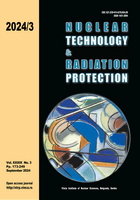
DOSE AND RISK ASSESSMENT OF RADON IN THREE ROOMS WITH VARYING VENTILATION LEVELS USING RESRAD-BIULD SOFTWARE

Vol.
XXXIX, No. 3, Pp. 173-249
September 2024
UDC 621.039+614.876:504.06
ISSN 1451-3994
Pages: 234-242
Authors: Walat A. H. AlhamdiAbstract
Radon, a radioactive gas, poses a significant health risk when accumulated in indoor environments. This study measured radon concentrations in three rooms with varying ventilation levels over a 12-month period, utilizing a Corentium monitor, an alpha spectroscopy-based radon detection device. The objective was to assess the impact of seasonal variations on indoor radon levels.The results indicated that the highest radon concentration, approximately 42 Bqm-3, was consistently observed in the closed room. In comparison, the partially closed room and the regularly occupied room with normal ventilation, had concentrations of 35 Bqm-3 and 31 Bqm-3, respectively. Across all three rooms, radon levels were lowest during the summer and peaked during the winter. The dose and risk associated with radon exposure were further analyzed using the RESRAD-BUILD computer code. All measured radon levels and associated doses were below the global safety limits. This study highlights the critical role of ventilation in controlling indoor radon levels and confirms that the environments studied remain within safe exposure thresholds.
Key words: radiological assessment, RESRAD- BIULD code, ventilation, meteorological parameter
FULL PAPER IN PDF FORMAT (1,10 MB)